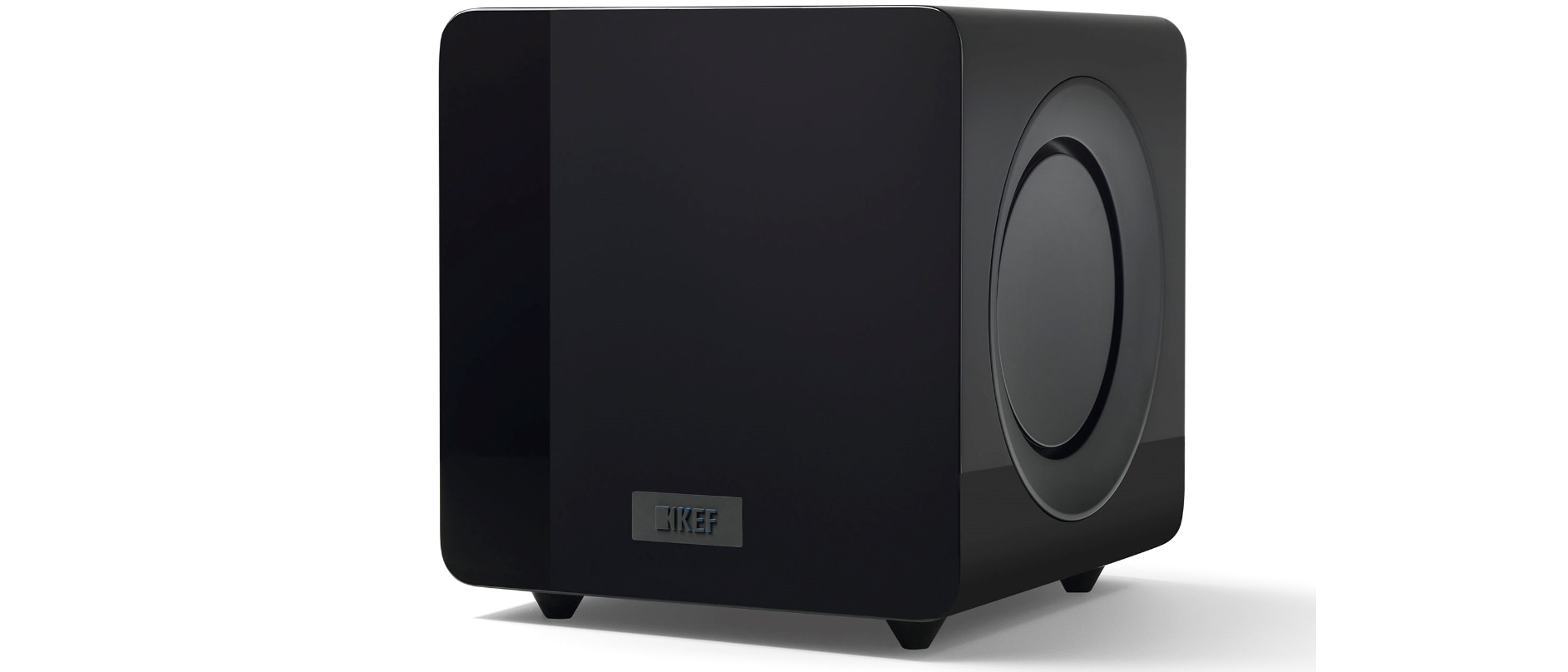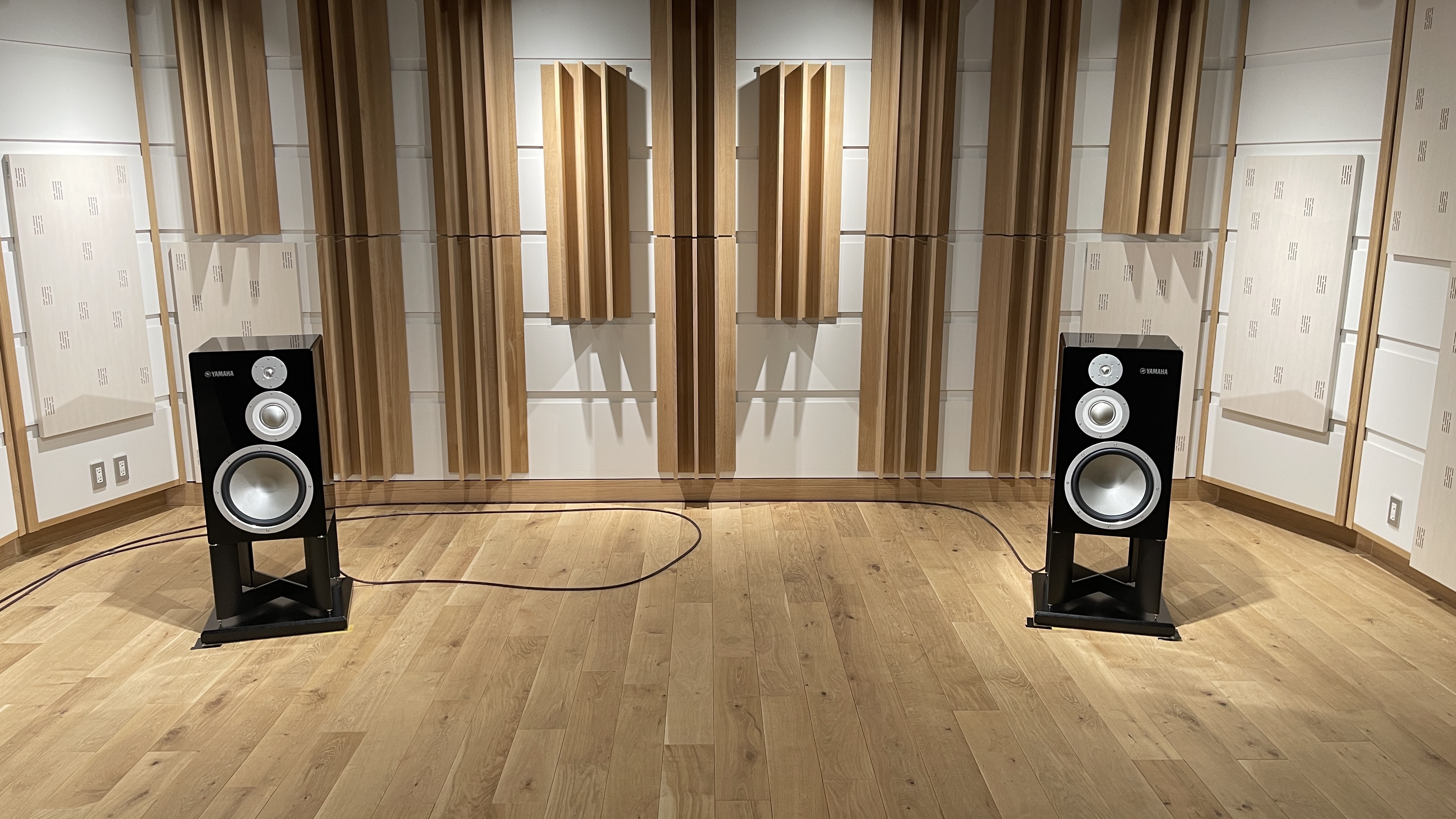What Hi-Fi? Verdict
While there are some very minor gripes about its controls and connectivity, the K92 from KEF brings some of the cleanest, deepest sub frequencies on offer, and does so in a charmingly compact enclosure.
Pros
- +
Deep bass extension
- +
Low distortion
- +
Compact dimensions
Cons
- -
Phase switch is limited
- -
Proprietary speaker terminals
Why you can trust What Hi-Fi?
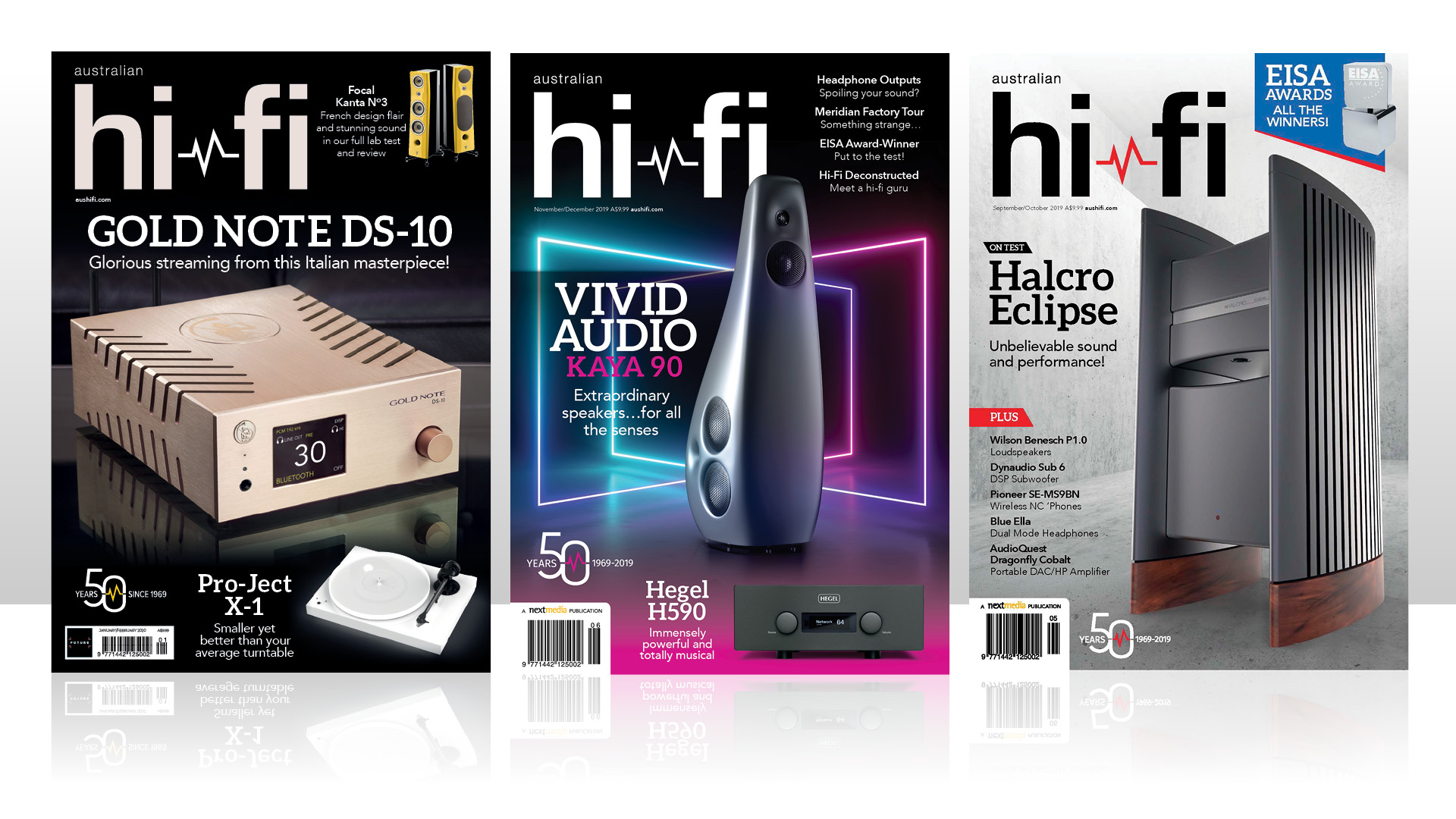
This review and test originally appeared in Australian Hi-Fi magazine, one of What Hi-Fi?’s sister titles from Down Under. Click here for more information about Australian Hi-Fi, including links to buy individual digital editions and details on how to subscribe.
Getting very loud, very low-frequency, distortion-free bass from a subwoofer is very easy. The only problem is the size, cost and number of bass drivers you’d need to use to do it, and the fact that the cabinet you’d need to accommodate them all would have to be so big that it would take up a good deal of the available space in the average-sized living room.
The various parameters – size, cost, number of drivers and so on – can certainly be manipulated, but ultimately the final result will always be governed by the immutable laws of physics… and you can’t get around them.
Not that subwoofer manufacturers haven’t tried… and KEF has tried harder than most. In order to ensure that one of its smallest-ever subwoofers could deliver deep bass it even invented an innovative circuit it called ‘Intelligent Bass Extension’ or IBx for short.
IBx is essentially an algorithm built into a DSP controller that counteracts the natural tendency for a bass driver to roll-off at low-frequencies but at the same time monitors what that driver is doing to ensure its safe operating parameters are not exceeded. KEF’s IBx circuit was so successful – and so popular with its customers – that KEF decided to use it in its larger subwoofers and, most recently, in this new KF92.
Equipment
The cabinet of the KEF KF92 is completely sealed, which has a number of advantages over the more common ‘ported’ or ‘bass reflex’ cabinet. The first and most obvious of these is that whereas bass reflex ports can sometimes create audible noises – usually ‘chuffing’ sounds, but sometimes whistling sounds – you won’t ever get these noises with the KEF KF92 because there is no port.
Another advantage is that because the cabinet is sealed, all the internal metal components are protected from corrosion, which can be a problem in hot, humid environments.
Yet another advantage is that – all other things being equal – a sealed enclosure has a smoother, more extended low-frequency roll-off and lower distortion than a ported enclosure. (Ported enclosures also have advantages over sealed enclosures, but we’ll deal with those a little later.)
Finally (but far from least, depending on where in the world you live) small furry (or non-furry) ‘critters’ cannot decide the inside of your subwoofer would make a very warm and comfortable home to which they could gain access via the bass reflex port.
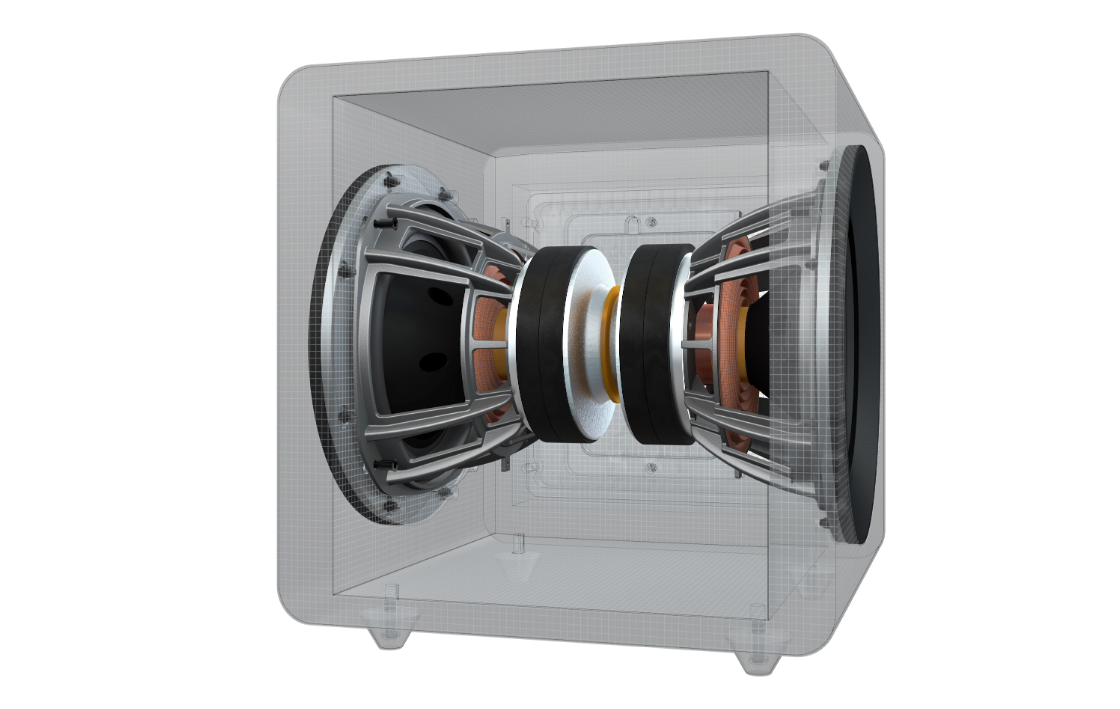
As you might be able to see from the photographs, the KEF KF92 has two bass drivers, mounted on opposite sides of the cabinet. It’s very important to note that unlike many subwoofers that use a similar mounting arrangement, both KEF drivers are connected to amplifiers.
Many subwoofers that appear to have two – or more – drivers have only one of those drivers connected to an amplifier: the other so-called ‘drivers’ are not drivers at all, but simply ‘drone’ cones or passive radiators that contribute very little to the main output of the subwoofer.
KEF appears to be using its own, custom-designed 230mm bass drivers in the KF92: These have hybrid cones made from aluminium-coated paper pulp. According to KEF, using paper pulp to form the cone keeps the mass low and ensures an accurate response, while the aluminium skin over the pulp increases the strength of the cone and provides damping.
Although KEF rates the driver with a diameter of 230mm, the design of the driver is such that the Thiele/Small diameter is 175mm, which gives an effective cone area (Sd) of 240cm² per driver, or 480cm² for the system.
This means that had KEF wanted to move the same amount of air with a single cone, rather than with two, it would have had to have had a Thiele/Small diameter 247mm, which would have translated to a specified diameter of 332mm.
So why does KEF use two drivers, rather than just one? The most obvious (but wrong!) reason is that since the cabinet is only 330mm wide overall, a driver that was 332mm in diameter simply wouldn’t fit! KEF uses two drivers for several very important reasons.
Perhaps the most important of these is that the thousand watts of amplifier power that KEF provides is far too high for a single driver’s voice-coil to dissipate. Spreading this power across two voice-coil assemblies is a far more reasonable engineering proposition.
The second-most important reason for using two drivers – though from reading the promotional literature, I have formed the impression that KEF thinks that it’s the most important reason – is that it effectively eliminates cabinet vibrations.
This is because the unwanted vibrational forces created by the drivers are equal to each other but also exactly opposite in phase to each other, so they cancel out. This is what KEF is alluding to with its claims for the use of ‘force-cancelling’ technology.
Also significant is that by using two 500-watt amplifiers, each one dedicated to a single bass driver, rather than connecting both drivers to a single 1,000-watt amplifier (which would at first glance seem to be the obvious method of doing it), is actually a far better idea.
Using this ‘single amplifier per driver’ approach as KEF has done with its KF92 means that the electromotive forces (EMF) generated by one driver cannot affect the other, or vice versa. Very clever!
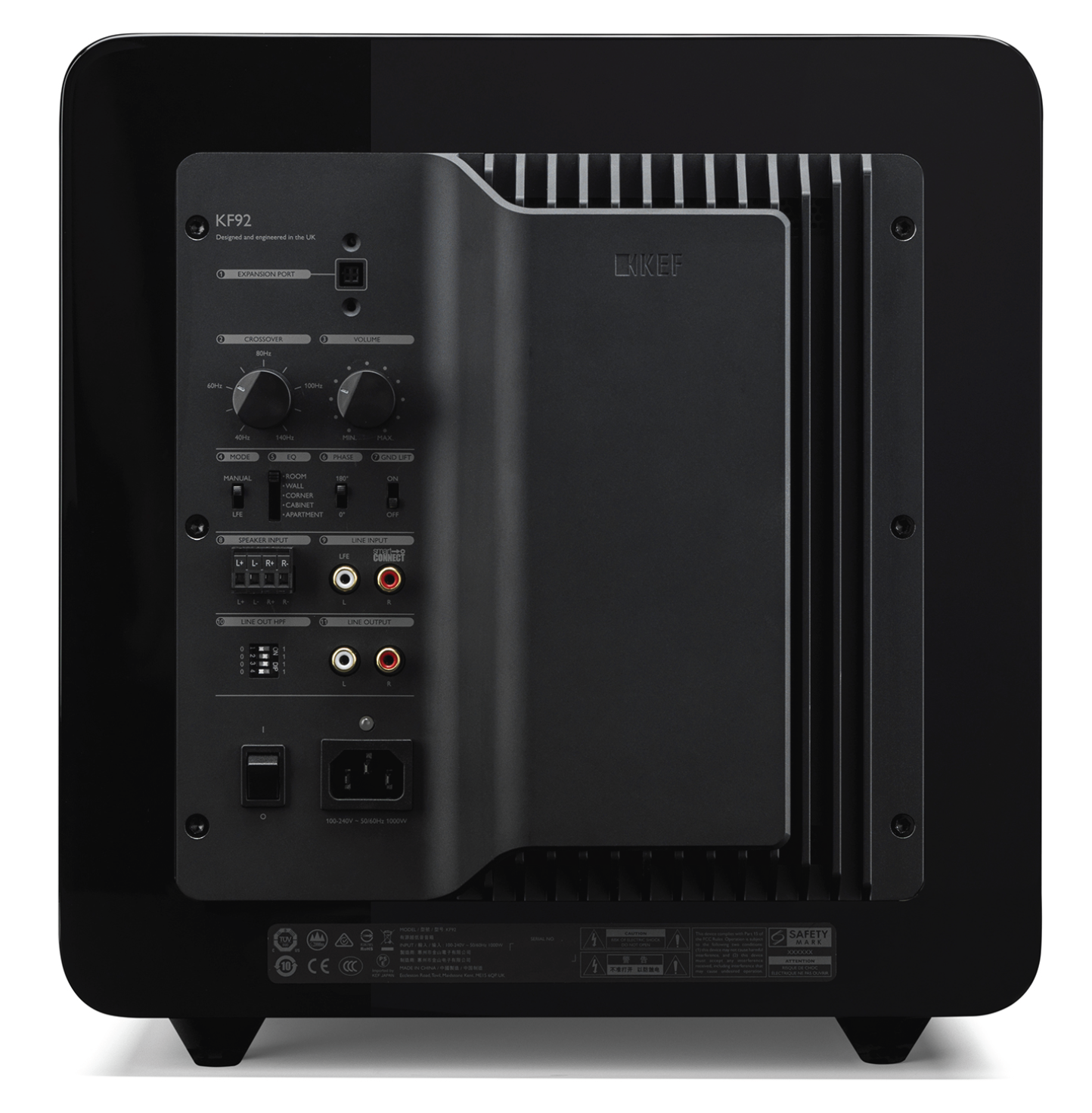
The control/connection plate fitted to the rear of the KEF KF92 is very obviously made by KEF, and the fit ‘n finish is absolutely astoundingly good. It simply oozes quality.
The very high power of the two 500-watt amplifiers is evidenced by the expanse of the heat-sinking, though most of this is obscured by an artfully contrived silky-smooth cover plate. Who was it said that Class-D amplifiers don’t generate heat? They obviously do if each one is rated with an output of 500-watts and there are two of them!
At the very top of the plate is an ‘Expansion Port’ that allows customers to add features they might like by plugging in optional devices. The first of these is the ability to send audio signals to the KEF K92 wirelessly, which will be enabled via a separately available wireless kit (KW-1).
This kit will also allow you to interface the K92 with other compatible KEF products, such as powered speakers… although you can already do this, as we will discover later. The KW-1 (or some later kit) may also allow you to control the volume remotely, but unfortunately we were unable to test any of this functionality, because the KW-1 kit was not available at the time this review was written..
Below the Expansion Port are two rotary controls, the left-most to set the KF92’s low-pass frequency, which can be anywhere between 40Hz and 140Hz, and the volume control. Both are high-quality stepped devices, so you can set frequency and level very easily and precisely and just as easily re-set them to the same exact levels if the settings are for any reason disturbed.
Below the two rotary controls are four slider switches that control (from left to right), Crossover Mode (Internal or External), Equalisation mode (Room, Wall, Corner, Cabinet and Apartment), Phase (0°/180°), and Ground Lift (On/Off).
The correct position of the Crossover Mode switch will depend on where you are sourcing the audio signal you’re using to drive the KF92. If it’s from a component that is supplying an audio signal that has already been through a low-pass filter (such as the LFE output of an AV receiver, for example) you’d set this control to ‘External’. If you’re sourcing from an ordinary line-level or speaker-level output, you’d set it to ‘Internal’, and then set the low-pass (crossover) rotary control to the appropriate frequency.
KEF’s equalisation mode control is fascinating. I don’t think I’ve seen its like before. Yes, I’ve seen EQ mode controls that offer two or three modes, (usually ‘Off’, ‘Wall’ and ‘Corner’) but I have never seen one that offers five modes… and I had absolutely no idea what the ‘Apartment’ mode might be used for – indeed I had to consult KEF’s Owners’ Manual to find out.
The reason for the EQ control is that because a subwoofer operates at such low frequencies – which means the wavelength of the audio signals are inordinately long – its output is dramatically affected by where it is positioned in your room relative to walls and furniture. KEF’s EQ settings adjust its output to ensure the KF92 will deliver its best performance no matter where in the room you end up putting it… even if you put it inside a cabinet.
As for that ‘Apartment’ EQ mode, the excellent instruction manual supplied with the KF92 contains the following advice about it: ‘Low frequency sound can travel through walls and be heard in adjacent rooms.
To avoid disturbing neighbours, set the EQ to ‘Apartment Mode’ to reduce the level of very low frequencies (below 40Hz).’ I can see how this would be very useful for apartment dwellers… even though it does kind of defeat the purpose for buying a subwoofer in the first place.
The phase control does the obvious, but I think that on such a high-quality subwoofer a rotary control would be a better choice than a simple phase reversal switch. As for that ‘Ground Lift’ switch, its sole purpose is to eliminate mains hum, should it be present. You should start with it in the Off position and, if you hear any hum, first check and re-arrange all your cables and check mains earths. If the hum persists, moving the switch on ‘On’ should reduce or eliminate it.
The KEF KF92 has both speaker level (high) and line-level inputs. The line-level inputs are provided via gold-plated RCA terminals, the left-most of which is for LFE connection: the right-most is essentially a duplicate. For connection to a preamp or similar, you’d use both terminals.
KEF has been very cunning with its speaker level inputs, because rather than provide bulky speaker terminals, it’s instead provided a custom four-pin plug to which you connect your speaker wires, which is then plugged into a small socket on the plate. This makes for a very neat installation, but does limit you to using speaker wire that will actually fit into the rather small connector.
Below the LFE/line-level inputs is a pair of line-level outputs. These can be set so the signals that appears there are simply a ‘loop-through’ from the line-level inputs, or you can route the audio signals through a high-pass filter to remove low frequencies before they appear at this output.
The available turnover frequencies for this filter are at 40Hz, 45Hz, 50Hz, 55Hz, 60Hz, 70Hz, 80Hz, 90Hz, 100Hz, 110Hz and 120Hz. Filter turnover frequency is selected by appropriately setting the four switches on the DIP switch located to the left of the line-level output. The same DIP switch can also be used to either let the output be stereo, or force it to mono.
The main power switch is obviously wired to make sense to owners in the US, because pressing the top of it inwards switches the subwoofer on (the exact opposite of switch operation in Australia and the UK). There’s a small tell-tale dual-colour LED above the switch that glows red when the subwoofer is off but power is available, and glows green when it’s operational.
The KEF KF92 is available in either a gloss white or gloss black painted finish. It measures 353 x 330 x 361mm (HxWxD) and weighs 20kg. You won’t have to worry about support spikes marking your polished wooden floor, because the KF92 comes with four conical rubber feet pre-fitted to it.
In use
The KEF K92 comes with a small (A5) but comprehensive 22-page User Manual in seven languages, though almost all the information is intended to be conveyed graphically, via images, rather like Ikea’s DIY furniture assembly instructions. It’s probably just me, but I found these very difficult to follow, despite the fact that KEF’s manual is a better-than-usual example of the genre.
Nevertheless, it has all the information you need to install the subwoofer, correctly position it in your room, and connect it to another subwoofer (if required) a pair of KEF powered speakers (such as the LS50S/LSK) or a pair of small unpowered speakers via a separate amplifier. Despite the accuracy of the instructions, you would benefit by positioning and calibrating the K92 by using our subwoofer setup guide to room placement and controls.
I first used the KEF K92 in conjunction with a small pair of bookshelf speakers. Nothing could have prepared me for the sound that resulted. It was as if I were listening to a pair of huge, floor-standing loudspeakers. The bass was awesome!
I have heard KEF subwoofers previously, and I’ve always been impressed by them. This is a company that has been building speakers for a very, very long time, and subwoofers for a long time, so it knows what it’s doing. But with the KEF K92 the company has nailed it.
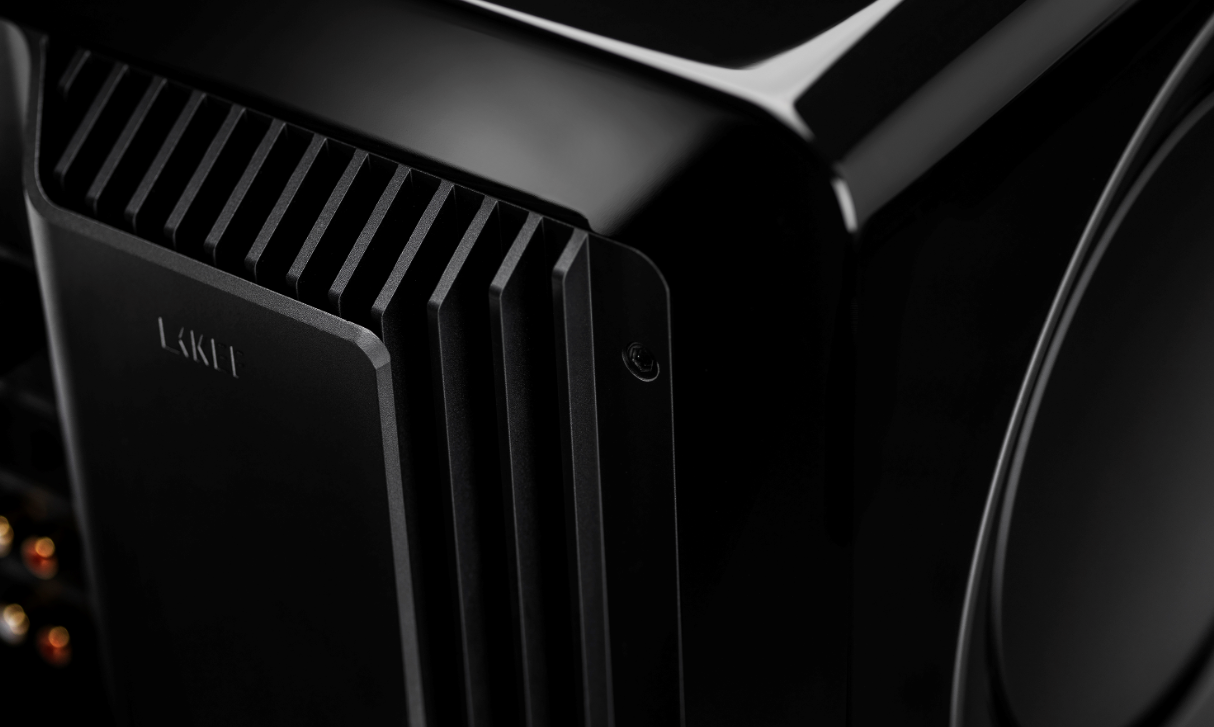
The first of my ‘deep-bass’ CDs I fired up was Telarc’s Bachbusters (CD80123). The bass from the KEF K92 was deep, powerful, and exceptionally taut, so there was no unwanted ‘hangover’ from one deep bass note to the next (an issue that mostly affects subwoofers with bass reflex cabinets). The K92’s bass was also incredibly clean.
The tonal quality of the deep bass (and the extension) was then proved even more when I played hi-res recordings of Bach’s most famous organ works, which require the organist to play notes so low they’re below the limit of most people’s hearing. The sound of the organ pipes was full, rich and textural and pitch differences were immediately evident, just as they should be.
The ‘tautness’ of the bass was again clearly evidenced. The KEF also made it easy to hear the sonic differences between the different pipe organs being played… no mean feat!
If you’re not into organ music, but you want a great demo of the depth and level of the bass the KEF KF92 is capable of delivering, listen to the ‘heartbeat’ on Pink Floyd’s ‘Dark Side of the Moon’ – preferably from a hi-res format rather from ordinary Red Book CD. The ‘pulse’ is incredible… you’ll feel it echoed in your own body.
But you don’t have to listen to deep bass to appreciate what the KEF KF92 can do for your music, because I think one of its greatest strengths is in the lower music region where notes played by instruments such as bass guitar, double bass, and French horn are found, basically from around 60Hz to 120Hz (this also includes percussion and keyboard, of course!).
Whereas most subwoofers sound a little ‘thick’ when reproducing sound across this octave, the KF92 was entirely musical with a light, deft touch. There was no sense of ‘ponderousness’ to the sound at all.
I then swapped out the stand-mount speakers and swapped in a pair of large, floor-standing speakers to use in conjunction with the KEF KF92… which, of course, meant re-calibrating the volume and crossover frequency controls all over again. Luckily, the app makes this a quick and easy process, and I was able to skip the subwoofer positioning step entirely.
This time, rather than use the KEF’s internal crossover as I had with the floor-standers, I ran the main speakers full-range, so I was really using the KF92 to reinforce to the main speakers’ own output, plus extend the bass downwards even further. In this role the little KEF KF92 again excelled. I found it impossible to hear the point at which it took over the deepest bass, so it was essentially a seamless integration.
The only real difference was that whereas with the stand-mounters the KF92 kept up as I turned the volume up, I thought it struggled just a little bit at very loud volume levels when used with the large floor-standers.
However, to inject some reality into this comment, I was listening at very high volume levels in a very large room. In a typically-sized suburban lounge room I don’t think you’d run into this issue, even at high playback levels.
This reminded me that (not living in an apartment, and therefore having no reason to think of it!) I had not tried out the ‘Apartment’ setting of the EQ control. So I flicked the switch. No difference at all.
I played one track after another. All the low bass was still present, and still perfectly reproduced. Huh? Then I twigged. I was playing regular music tracks. So I switched to a movie soundtrack (Jurassic Park). Now I heard a difference.
Those thumping footsteps of the Tyrannosaurus? Greatly muted. The other low-frequency sound effects? There, but effects that usually rattled the walls no longer did so. When I switched back to ‘Room’ (the EQ setting I used throughout the entire reviewing process), it all returned.
Final verdict
The only issue with wrapping up this review is that I’ve already wrapped up because, as I wrote earlier, the bass from the KEF K92 is awesome!
This is a subwoofer from a company that has been building subwoofers for a long time, and hi-fi loudspeakers for a whole lot longer, so it knows what it’s doing, but with the KEF K92 the company has excelled itself… it’s really nailed the brief.
I know this is a big call in a crowded market, but I’d say KEF’s K92 may be the best small subwoofer of them all.
Test lab results
Newport Test Labs first measured the frequency response of the KEF KF92 in a room, using pink noise as the test stimulus, with the EQ setting set to ‘Room’, the result of which is shown in Graph 1.
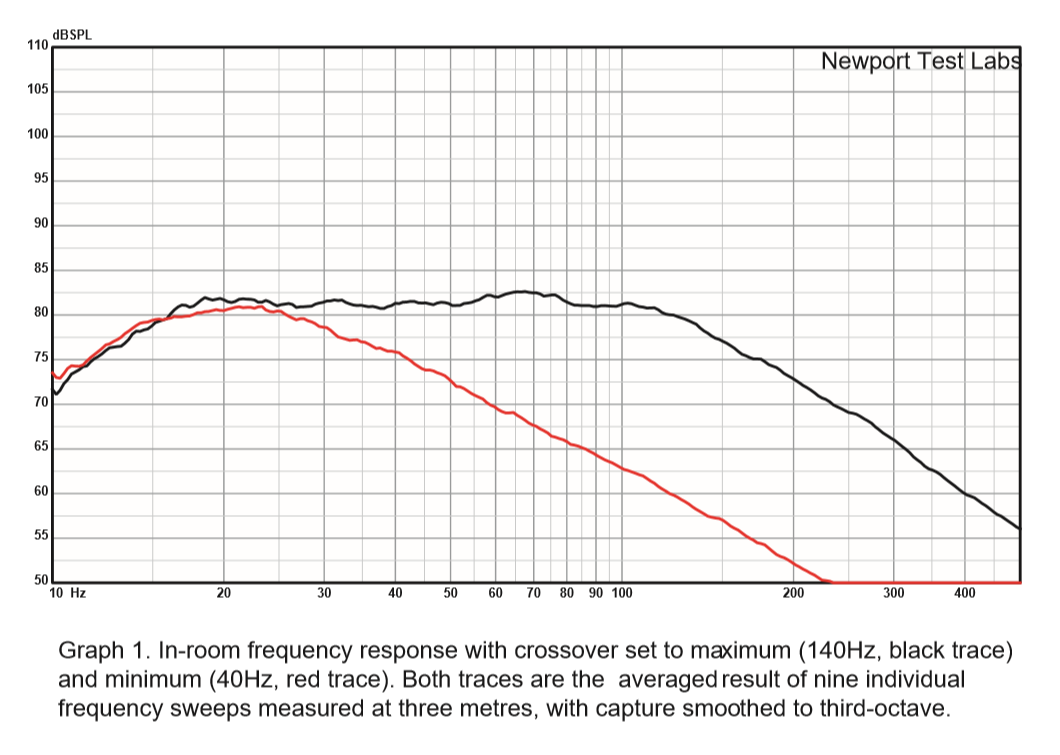
The black trace on this graph shows the response with the low-pass crossover set to maximum (140Hz) and you can see the flatness and extension of the response is exemplary, extending from 14Hz to 160Hz ±3dB. Across the region from 16Hz to 125Hz the response is ±1.25dB, which is extraordinarily linear for a subwoofer.
Looking at this graph you can see that maximum output is at 65Hz and the trace is 12dB down at 10Hz and 10dB down at 200Hz. With the low-pass crossover set to its minimum (40Hz) position (red trace) peak output is at 22Hz and the response is then 3dB down at 35Hz and 10dB down at 55Hz. The roll-off is beautifully smooth and linear.
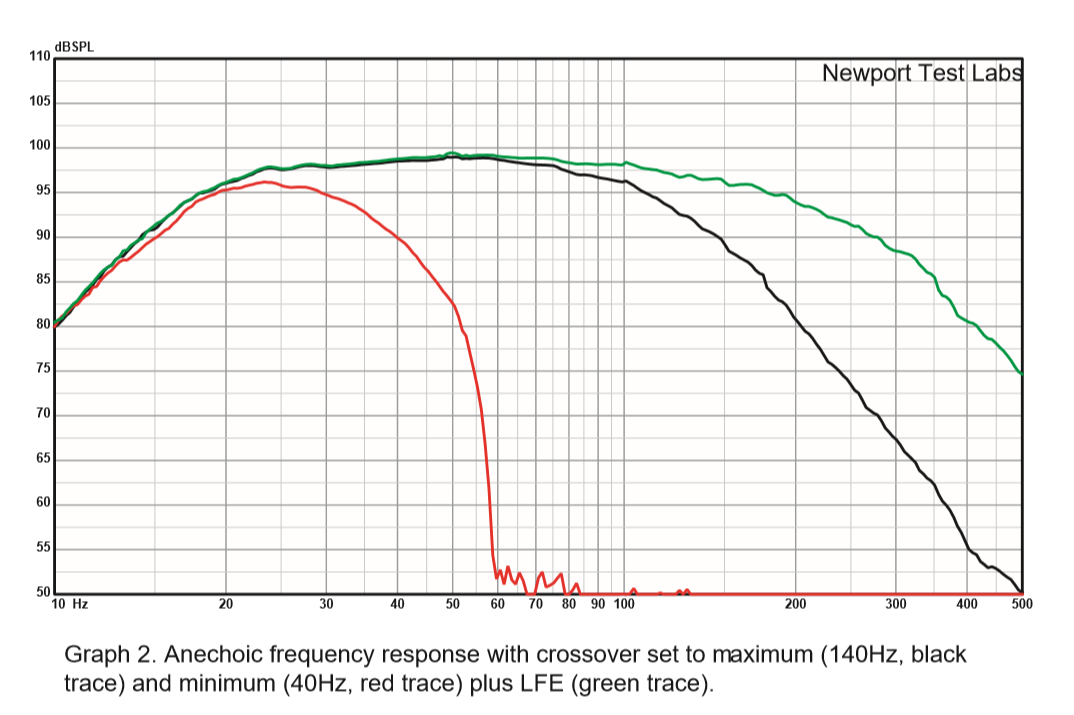
Graph 2 shows the anechoic frequency response of the KEF KF92 for the LFE (bypass) mode (green trace) and the maximum (black trace) and minimum (red trace) settings of the low-pass crossover control.
Again, the linearity across the pass-band is outstandingly good, such that the frequency response in the KF92’s LFE mode extends from 17Hz to 200Hz ±3dB. With the crossover control at maximum (140Hz) so the KEF is actively rolling-off the high-frequency response, the response extends from 17Hz to 130Hz ±3dB.
With the crossover control set for a 40Hz turnover, the response peaks at 23Hz and is 3dB down at 18Hz and 35Hz. The truncated low-frequency extension is due to the anechoic measurement.
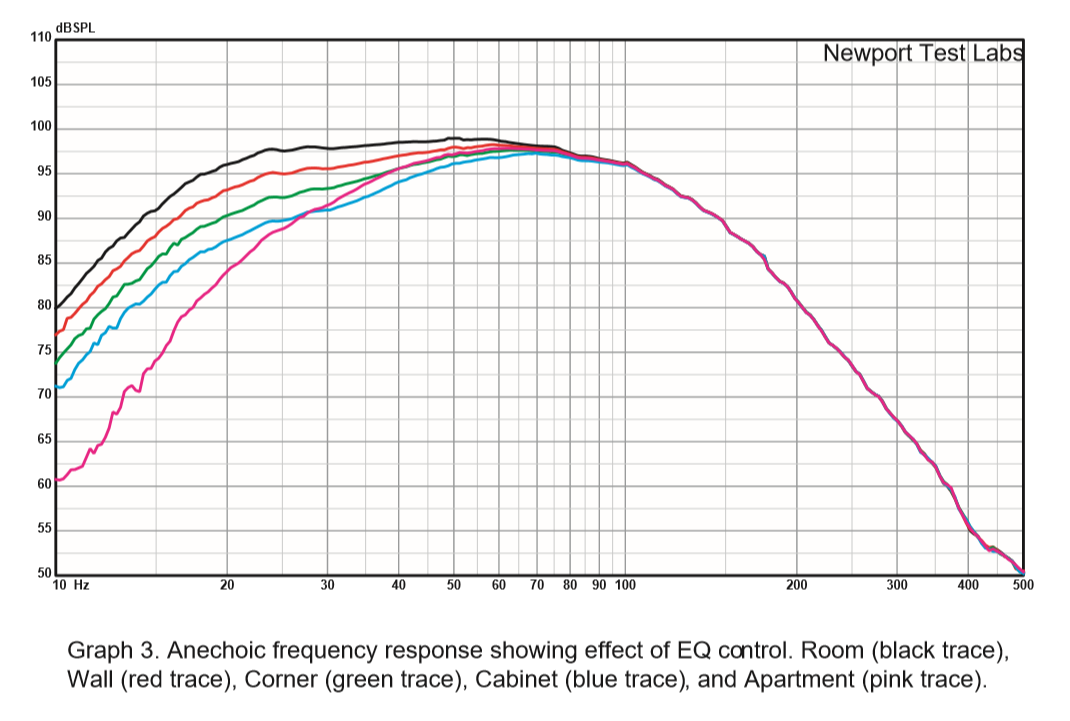
Newport Test Labs measured the effect of the EQ control on the KEF K92’s frequency response, the results of which are shown in Graph 3. As expected, the ‘Room’ EQ mode – which assumes the subwoofer is not getting any assistance from nearby walls – delivers the maximum output at low frequencies (black trace).
The red trace shows the effect of the ‘Wall’ EQ mode – which assumes the subwoofer is getting assistance from a nearby wall – effectively reduces the output of the K92 by about 6dB at low frequencies. ‘Corner’ EQ (green trace) drops output at low frequencies by a further 6dB, while ‘Cabinet’ EQ drops it by yet another 6dB.
All these EQ modes have roughly similar equalisation curves, with the turnover for all taking place at around 70Hz. The ‘Apartment’ EQ on the other hand, has a completely different equalisation constant applied to it that means it will deliver more bass above 30Hz than the Cabinet mode, and more above 40Hz than both ‘Cabinet’ and ‘Corner’ modes, but its low-frequency response cuts off very steeply below 25Hz.
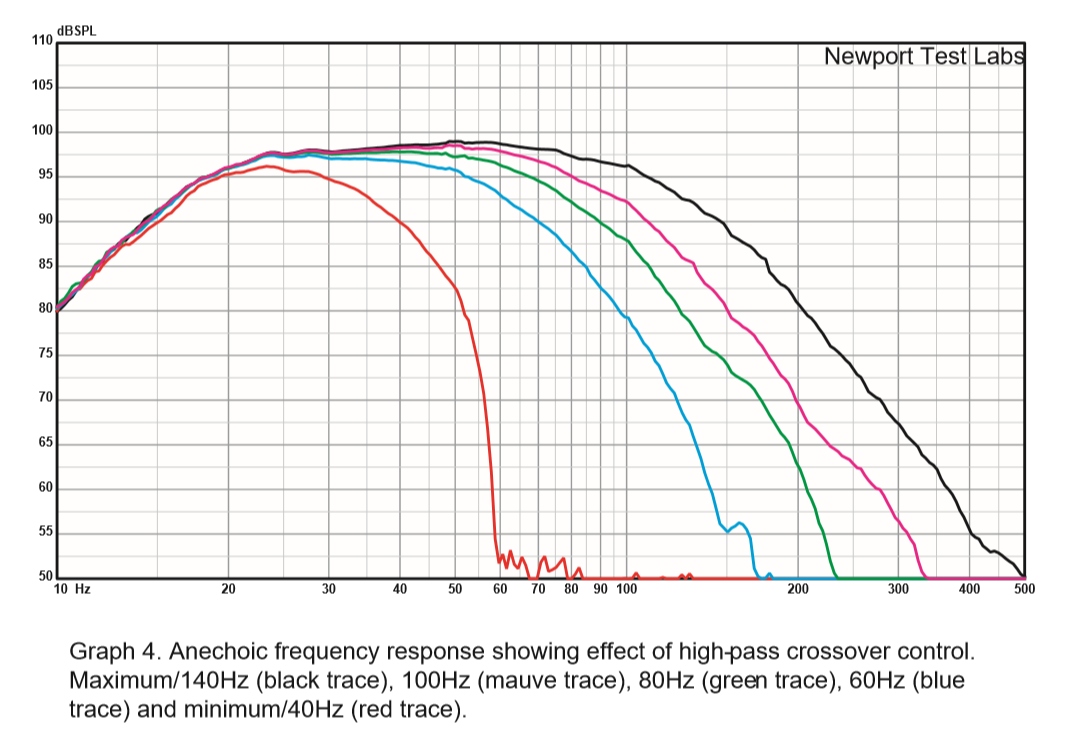
Graph 4 is very similar to Graph 2, but on it Newport Test Labs has added traces for the response when the low-pass crossover is set at 100Hz (mauve trace), 80Hz (green trace) and 60Hz (blue trace). You can see that all three traces are around 6dB down at 100Hz, 80Hz and 60Hz respectively, so KEF’s calibration points are spot-on.
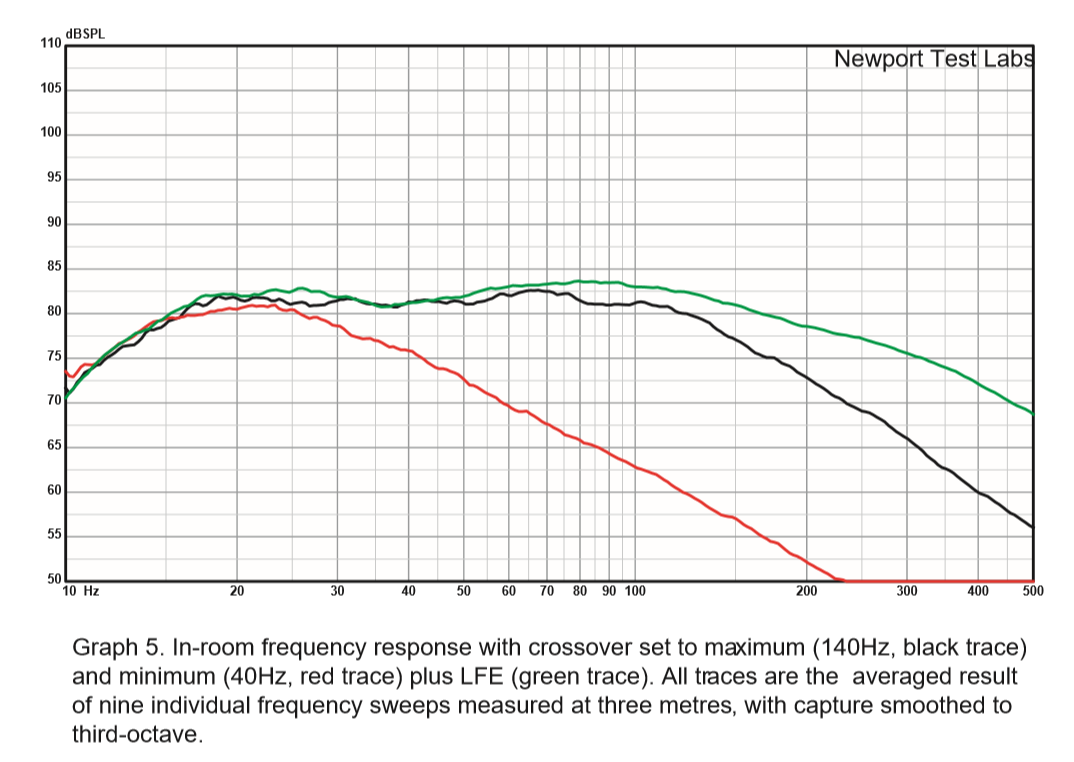
The black and red traces on Graph 5 are identical to those on Graph 1, but Newport Test Labs has extended the frequency range covered by the graph to allow it to add in the frequency response via the LFE input (green trace) measured using the same acquisition technique.
Overall, Newport Test Labs’ measurements show that the KEF KF92 is an exceedingly well-designed subwoofer which returns excellent performance across all its operating modes.
Australian Hi-Fi is one of What Hi-Fi?’s sister titles from Down Under and Australia’s longest-running and most successful hi-fi magazines, having been in continuous publication since 1969. Now edited by What Hi-Fi?'s Becky Roberts, every issue is packed with authoritative reviews of hi-fi equipment ranging from portables to state-of-the-art audiophile systems (and everything in between), information on new product launches, and ‘how-to’ articles to help you get the best quality sound for your home. Click here for more information about Australian Hi-Fi, including links to buy individual digital editions and details on how best to subscribe.
-
ThrasherBear The very thorough review states that the KF 92 is available in gloss white. Alas, that is not the case—only black. Seems rather shortsighted to not have the sub which is clearly intended to match with the LS50 not come in matching finishes.Reply -
Leon7791 Hello Team What Hifi,Reply
i have a question about the KEF KF92. Show your measruemnts the max Output from the Sub? I have bigger Livingroom (35qm) now i have the KEF kube12b and plan to replaced it with this sub. Do you thing the smaller but stornger KF92 will outperforme it?
